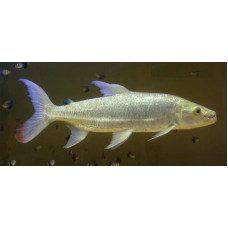Latin name
Hydrocynus goliath
Other name
Goliath tigerfish, giant tigerfish, or mbenga.
Identification
The Goliath tigerfish has a body shape similar to a tuna's. Due to their predatory nature, they have well-developed pharyngeal teeth similar to those of sharks and piranhas. There are six to seven teeth in the premaxilla and five in the dentary, or lower jaw. This makes for a total of 12 to 20 upper teeth and 8 to 14 lower teeth. These teeth are arranged in distinct rows along the jaws, with the smallest located at the back. All of the teeth are replaced simultaneously over a period of about five days. On average, each tooth can grow up to 2.5 cm (1 inch), comparable in size to a great white shark's teeth.
Features of fish fins
Dorsal fin – 1, located on the back.
Pectoral fins – 2, one on each side of the body.
Pelvic fins – 2, positioned near the belly.
Anal fin – 1, found closer to the tail on the underside.
Caudal fin – 1, powerful and forked, enabling fast movement.
Adipose fin – absent.
Fish colouring
The Goliath tigerfish has a distinctive silvery-gray back and sides and black adipose fins.
Distribution
It is found in the Congo River basin, the Lualaba River, Lake Upemba, and Lake Tanganyika, all of which are located in Africa.
Habitat
They are a tropical, freshwater, pelagic species. It usually inhabits fast-flowing, oxygen-rich waters, such as deep river channels and open lakes. This makes it a strong swimmer capable of catching prey in turbulent waters. The ideal water temperature is 23–26 °C with a pH of 6.5–7.5.
Size
This large, predatory fish has large teeth and reaches an average length of 1.5 meters (4.9 feet) and a weight of 50 kilograms (110 pounds). The largest recorded specimen weighed 154 pounds and reached a maximum length of about 6.6 feet, making it the largest species in the genus Hydrocynus.
Behavior
Although female Goliath tigerfish hunt alone, they migrate and reproduce together on the banks of rivers or lakes.
When hunting, this fish uses the calm eddies of rapids to lure prey into an ambush. It uses its sharp eyesight to spot prey. Once a target is spotted, the fish accelerates to chase it.
Food and feeding habits
Predator: Their teeth are spaced apart along the jaw and are shaped like daggers, which facilitates biting off pieces of fish or tearing them into smaller pieces for digestion.
They are fish-eating animals that feed on any fish they can handle, including smaller members of the same species. Their huge, rigid, powerful teeth make them one of the most ferocious predators in the Congo Basin. They are dangerous to the small fish they hunt and to the hunters who try to catch them for sport or food. They are known to attack larger animals, including large fish, crocodiles, humans, and even each other in desperate situations.
Juvenile fish feed on plankton during the larval stage, then switch to small fish and ultimately an adult diet of larger fish.
Reproduction
Given that these fish are inattentive parents, thousands of eggs are laid among dense vegetation to protect the eggs and fry from predators.
The young fish grow slowly, averaging four to six inches per year. It can take up to ten years for tigerfish fry to reach their full adult size.
Fishing
The Goliath tigerfish is a popular target for sport fishing in Africa. People hunt the Goliath tigerfish for food and recreation.
Relationship with a person
It is well known among aquarium enthusiasts. It is kept in exhibition aquariums that have shelters and powerful filtration systems.
There have been several reports of this fish attacking humans in the Congo.
The goliath tigerfish plays an important role in the diet and economy of many African countries. However, dried fish usually contains bacteria.
| Classification | |
| Phylum | Chordata |
| Class | Actinopterygii |
| Squad | Least Concern |
| Family | Alestidae |
| Genus | Hydrocynus |
| Species | H. goliath |
| Features | |
| Conservation status | Least Concern |
| Habitat | Pelagic |
| Life span, years | No information |
| Maximum body weight, kg | 70 |
| Maximum length, cm | 200 |
| Sailing speed, m/s | No information |
| Threat to people | Edible |
| Way of eating | Predator |
Goliath tigerfish
Tags: goliath tigerfish



